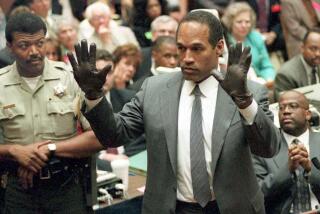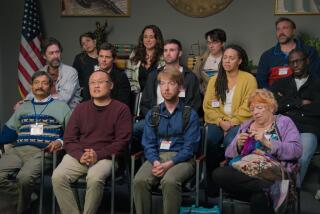On View : Courtroom Fever : ON THE DOCKET: MORE SHOWS IN THE MOLD OF COURT TV
- Share via
Jeffrey Mann faces an Ohio judge because his pit bull mauled and killed his wife, and he was charged with murder for ordering the attack.
Verdict: Guilty.
Welcome to “Court TV: Inside America’s Courts,” the 1990s answer to “The People’s Court,” where TV jurisprudence has taken a big leap from disputes over unpaid laundry bills and overgrown trees. Thanks to more liberal laws governing cameras in the courtroom, the show packs two actual courtroom tales into a half-hour. There are no actors, no retired judges, no sound stage.
“This is real-life drama,” says Robert Friedman, president of New Line Television, which distributes and co-produces the show with the Courtroom Television Network. “You can’t script this better in many cases. What it does is take some of the mystique off the courts and open up the proceedings in a very responsible way.”
Other shows are jumping on the legal bandwagon. Three other court-oriented series, still being sold to stations, are expected to debut come fall: “Judge & Jury” with KFI-AM legal talk-show host Bill Handel, “Jones & Jury” with NBC News legal correspondent Star Jones, and “I Accuse,” featuring face-to-face confrontations between crime victims and defendants.
“People have always loved the courtroom drama,” Handel says. “It’s where human drama is at its most real, compelling gut level. But it’s not really a new phenomenon. If TV cameras were around (in the 1920s), you would have people flocking to their sets to watch the Scopes trial.”
The newest genre has its incarnations in the 1991 launch of Court TV, the 24-hour cable network that features gavel-to-gavel coverage of trials across the country.
“There’s more interest in this because there’s more alienation in society,” says Jonathan Kotler, professor of journalism at USC and an expert in media law. “Watching people go through trials and their real-life trauma allows people to vicariously connect with it.”
But Court TV can be seen in only 14.4 million households. So Friedman and Court TV founder Steve Brill launched the syndicated show last fall in a bid to cross-promote the channel. In markets covering 92% of the country, “Inside America’s Courts” reaches about 86 million households.
On Court TV, “We had some of the most extraordinary moments on TV I have ever seen,” says Andrew Regal, executive producer of “Inside America’s Courts.” “But so few people were able to see it. What this does is give them the best and most interesting cases.”
Court TV and “Inside America’s Courts” also featured coverage of the high-profile trials of Lyle and Eric Menendez, brothers who confessed to killing their parents in their Bel-Air home but who pleaded self-defense. And viewers were inside the same courtroom of Katherine Ann Power after she surrendered to police in Boston for her role in a bank robbery and shooting of a police officer 23 years ago. Among their most popular segments, Regal says, was the coverage of Charles Manson’s parole hearing.
“It’s no wonder, because it was just fascinating,” Regal says. “But we didn’t just throw Manson out and say, ‘What a wacko this guy is.’ We explained the process and why he was up for parole.”
Many cases airing on the show, however, haven’t otherwise made it out of hometown newspapers. A segment that aired earlier this month featured a 16-year-old skier who became a quadriplegic when he went off a ski jump at Killington Ski Resorts in Vermont. He won, and was awarded $4.2 million. But the jury also agreed that he was reckless--and immediately cut its judgment in half.
The trial was “an interesting tug of war between both sides,” says host Gregg Jarrett. “People learn what their rights are. This is not murder and mayhem programming. We really try to do a wide variety of things.”
“If you really look at the pieces carefully, you see that we will do a great deal of explaining about the law,” Regal says.
The same attention to the legal system is planned for court shows still on the docket. “I Accuse” features mediation sessions, which are attempts to resolve cases before they reach trial.
Then there are the talk/court TV hybrids. On “Jones & Jury,” Jones, a former Brooklyn, N.Y. prosecutor, will arbitrate real-life civil disputes.
“People on today’s talk shows expose their souls, but there is no resolution at the end,” Jones says. “You’ll just hear a promo for the next show about big-breasted women. This is different.”
On her show, the studio audience will vote on a judgment, and the litigants will be bound by their decision. But Jones says it will not fall victim to what she calls “coliseum justice.”
“I’ll explain the law and how (the audience) should go about making their decision,” she says.
On “Judge & Jury,” Handel will serve as a quasi-judge and 12 audience members will serve as jurors. Cameras will record their deliberations, a la “12 Angry Men.”
“This brings (the talk show) to another level,” says executive producer Kari Sagin. “There are (legal) rules we have. People will come here and tell about their lives, but they know it will not be a circus.”
“Court TV: Inside America’s Courts” airs at 6 p.m. Saturdays on KCBS.
More to Read
The complete guide to home viewing
Get Screen Gab for everything about the TV shows and streaming movies everyone’s talking about.
You may occasionally receive promotional content from the Los Angeles Times.






